India’s external buffers are sufficient to cushion risks associated with rapid monetary policy tightening in the US and high global commodity prices, and risk to the sovereign rating from external pressure is limited, Fitch Ratings said on Wednesday.
It expects the country's foreign exchange reserves to remain robust and current-account deficit (CAD) to be contained at a sustainable level and reach 3.4 per cent of GDP this fiscal year, up from 1.2 per cent in last financial year.
"India’s external buffers appear sufficient to cushion risks associated with rapid monetary policy tightening in the US and high global commodity prices," Fitch Ratings said, adding risk to India’s sovereign rating from external pressures is limited.
Advertisement
It said public finances remain the key driver of the rating and India is relatively insulated from global volatility due to the sovereign’s limited reliance on external financing.
India’s foreign reserves fell by almost USD 101 billion in January-September 2022, but are still large at around USD 533 billion.
The decline has reversed much of the reserve accumulation that occurred during the pandemic, and reflects valuation effects, a widening CAD, and some intervention by the Reserve Bank of India (RBI) to support the rupee’s exchange rate.
"Reserve cover remains strong at about 8.9 months of imports in September. This is higher than during the “taper tantrum” in 2013, when it stood at about 6.5 months, and offers the authorities scope to utilise reserves to smooth periods of external stress.
Advertisement
"Large reserves also provide reassurance about debt repayment capacity. Short-term external debt due is equivalent to only about 24 per cent of total reserves," Fitch said.
Fitch has the lowest investment grade rating 'BBB-' on India. In June, it had improved the rating outlook to 'stable' from 'negative'.
Fitch's commentary comes close on the heels of US-based agency S&P Global Ratings saying India is facing a 'cacophony of factors' that may shake its sovereign credit metrics but the strength of strong economic growth rate and external balance sheet is expected to neutralize the risks inherent in the treacherous global environment.
India's strong economic growth rate has long been an important counterbalance to its high fiscal deficits and debt burdens, and its sound external balance sheet helps as a buffer against global market turbulence, S&P had said in a credit FAQ published on October 12.
In its report, Fitch said India's gross external debt stood at 18.6 per cent of GDP in second quarter of 2022, which is low compared with the median of 72 per cent for ‘BBB’ rated sovereigns in 2021.
Sovereign exposures are small, with only about 4 per cent of GDP in primarily multilateral financing. Foreign investor holdings of domestic sovereign debt represent under 2 per cent of the total, reducing risk of spillovers to the wider market should they seek to reduce their exposure.
Advertisement
This fiscal imports have surged on strong domestic demand growth and high oil and coal prices. Meanwhile, export growth has moderated from the fast pace seen in January-June 2022, amid decline in prices of steel, iron ore and agricultural products.
"Recessions in key European and US export markets will weigh on near-term export prospects. However, we forecast the CAD to narrow in FY24, to 2 per cent of GDP, as easing global energy prices will also dampen imports. Our robust medium-term economic growth outlook on India should facilitate financing of the deficit, particularly from FDI," it added.
On exchange rate, US-based Fitch said it expects Indian authorities will continue to use reserves to manage exchange-rate volatility.
Advertisement
"Domestic factors are the primary driver of the RBI’s current monetary policy tightening. However, risks to our current forecast that India's repo rate will peak at 6 per cent in 2023-24 are skewed to the upside, as there is a significant chance of rate hikes in the US beyond those in our assumptions, which could put further downward pressure on the rupee and increase imported price inflation," Fitch added.















 Just one email a week
Just one email a week